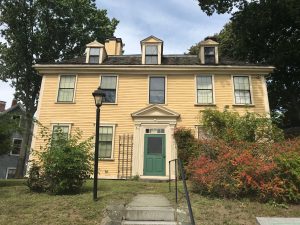 It has been a while since I’ve written an installment about the Rev. Thomas Cary’s diary. Indeed, it has been a while since I’ve written a post about anything, since I’ve been on a five-week trip with my husband along the East Coast as part of his sabbatical. Now I’m back and have loads of great new stuff to share!
It has been a while since I’ve written an installment about the Rev. Thomas Cary’s diary. Indeed, it has been a while since I’ve written a post about anything, since I’ve been on a five-week trip with my husband along the East Coast as part of his sabbatical. Now I’m back and have loads of great new stuff to share!
The first is my pilgrimage to the Chelsea, Massachusetts, house that Thomas wrote of staying in regularly sometime after his mother’s death. It is the oldest house surviving in this area and is open to the public, but not on a regular basis. The next general opportunity is their annual fundraiser: “Governor Bellingham’s Harvest Supper” on Saturday, 3 November. I’m not sure if there are any tickets left for this moderately-priced ($30) event, but the number to call for information is 617-884-4090.
Like many ancient houses, it has been expanded and remodeled over the years, and various theories have arisen to explain how and when it came into existence. Governor Richard Bellingham – by all accounts an obstinate man, who presided at his own trial on charges of improperly officiating at his marriage to his own ward! – acquired the property in the mid-seventeenth century and built a hunting lodge there around 1659. What part, if any, survives in the present house is uncertain.
According to dendrochronology, at least some of the wood tested dates to 1707–8, but most dates to 1722–23 … except for the upper and lower rooms in the back of the house opposite the kitchen. That section was added about the time Thomas Cary’s father died in 1769, until which time the house was L-shaped.
The ceilings in the Governor Bellingham-Cary House are uncommonly tall for an early eighteenth-century house, and another unusual feature is that fine moldings and paneling were employed while leaving rough upright beams. Usually such beams are either smooth or encased in finished wood, but these appear never to have used either technique. Whatever its exact history and eccentricities, it was certainly amazing to be able to tour this house inherited by my great-great-great-great-great-grandfather’s older half-brother and nephew.
 My favorite object on display was the Cary coat of arms, finely embroidered on black silk, a typical art form in late-eighteenth century Boston. I later saw a very similar one featuring the Thomas family coat of arms in the Metropolitan Museum of Art in New York City (acquisition number 36.28). Somehow the Cary specimen survived extremely un-archival storage in the house’s front entrance hall – where humidity and full sunlight could work their worst – for more than two centuries, and still is gorgeous today. The real silver threads tarnished to dull gray long ago, except for those over the back cross-pieces of the frame, where anti-oxidizing properties of the wood have left a bright silver “x” on the shield’s surface.
My favorite object on display was the Cary coat of arms, finely embroidered on black silk, a typical art form in late-eighteenth century Boston. I later saw a very similar one featuring the Thomas family coat of arms in the Metropolitan Museum of Art in New York City (acquisition number 36.28). Somehow the Cary specimen survived extremely un-archival storage in the house’s front entrance hall – where humidity and full sunlight could work their worst – for more than two centuries, and still is gorgeous today. The real silver threads tarnished to dull gray long ago, except for those over the back cross-pieces of the frame, where anti-oxidizing properties of the wood have left a bright silver “x” on the shield’s surface.
Stay tuned for more about the Rev. Thomas Cary and his family … including something curious I discovered at the Met!
Share this:

About Pamela Athearn Filbert
Pamela Athearn Filbert was born in Berkeley, California, but considers herself a “native Oregonian born in exile,” since her maternal great-great-grandparents arrived via the Oregon Trail, and she herself moved to Oregon well before her second birthday. She met her husband (an actual native Oregonian whose parents lived two blocks from hers in Berkeley) in London, England. She holds a B.A. from the University of Oregon, and has worked as a newsletter and book editor in New York City and Salem, Oregon; she was most recently the college and career program coordinator at her local high school.View all posts by Pamela Athearn Filbert →